TenSpot: Top Ten First-Person Shooters
This edition of TenSpot explores the staff picks for the top ten best first person shooters of all time.
With the impending releases of Unreal Tournament 2004, Battlefield Vietnam, Half-Life 2, Far Cry, Doom 3, Halo 2, S.T.A.L.K.E.R., and others, many people might say that this year will begin another golden age of first-person shooters. What better way to gear up for the onslaught of releases than with a TenSpot to commemorate the top 10 first-person shooters of all time? After all, when the dust settles after this year, there will likely be some new contenders for the list.
Before we dive into the list, we should first define a first-person shooter. FPS games emphasize action, so you won't see games like System Shock 2 or Deus Ex on this list. Yes those are great games, and they are played from a first-person perspective, but really, they share too much in common with a role-playing game like Morrowind to be called true first-person shooters. Otherwise, we'd end up lumping games like Ultima Underworld together with Quake, and anyone can see that would be a silly proposition. And while a compelling multiplayer mode isn't a strict requirement for a true first-person shooter, our list shows that a shooter without a strong multiplayer component just doesn't quite hold up over the long run.
So what makes a first-person shooter good? Is it a cohesive story and a well-designed campaign? A creative multiplayer mode? How about a devastating arsenal of weapons? Or fiendishly clever AI enemies? The games in this list exhibit one or more of these qualities and have all affected the way shooters are made in a tangible and lasting way. The games in this list are stretched all across the timeline, from the days of the very first shooters, through the first golden age of shooters in the late '90s, and on up to more contemporary shooters that are still widely played today. As with every TenSpot, the games listed aren't in any particular order, so don't go reading between the lines, thinking we've ranked them. All of these games stand together in their collective greatness.
It wasn't hard coming up with a list of worthy candidates for the list, since the first-person genre is among the most popular in the GameSpot office, as it is in the general marketplace. The difficulty came in making final cuts and leaving off some games that we loved very dearly but that just didn't quite make the grade for this list.
Have we done a major injustice? Left off a first-person shooter that you absolutely loved to death? You've got a chance at the end of this feature to vote on your favorite shooter, or you can just e-mail us. We'll revisit the issue later in a reader's choice edition of TenSpot, where we'll pick and publish the best entries submitted to us via the voting page.
Battlefield 1942
Platform: PC
Developer: Digital Illusions
Release: 2002
We're sure at least a few of you out there are surprised to see a game this recent appear in this TenSpot feature. After all, doesn't this World War II shooter from Digital Illusions CE owe a whole lot to other games, like Starsiege: Tribes, the team-based shooter from late, great developer Dynamix? Sure it does--even Digital Illusions has admitted this. And while Tribes featured a then-innovative emphasis on team play, unusual physics, and drivable vehicles, Battlefield 1942 brought everything together into a single game that had, and still has, plenty to offer, yet was, and still is, playable by anybody. Two years after the game's release, it's still going strong, thanks to its solid gameplay and community support.
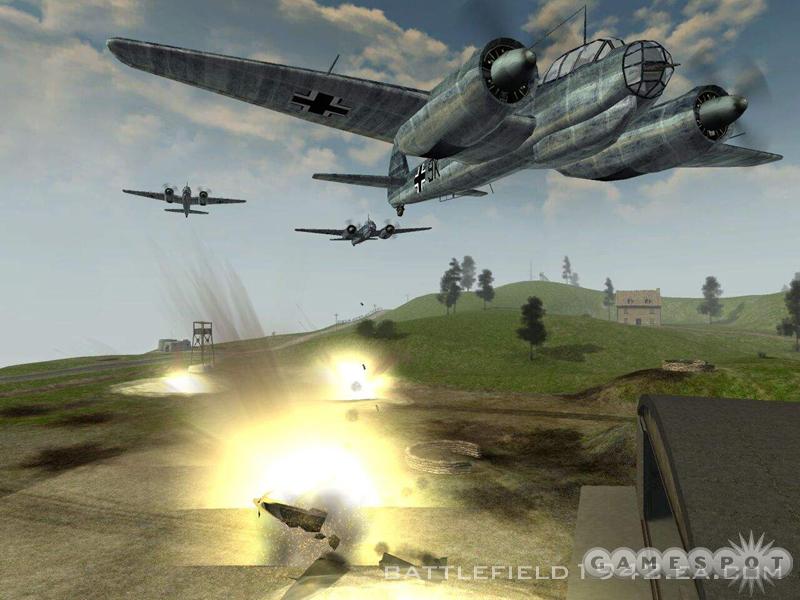
Battlefield 1942 let you play as either an Axis or Allied soldier in WWII, equipped with weaponry modeled after the war's conventional armaments. It also had authentic WWII vehicles, including tanks, artillery, battleships, destroyers, and fighter planes. At a glance, it almost seemed like an inscrutable, hardcore military simulation for experts only, but it struck a careful balance between realism and fast-paced action that was punctuated by great-looking graphics and terrific variety. Sure, anyone could hop into a fighter plane, take off, and try to go on a bombing run, but only truly skilled pilots could make it past the gauntlet of enemy fighters and flak cannons on the ground.
Then again, even if you weren't an ace pilot, you could simply parachute out near a watchtower, climb the tower to pick off incoming enemy soldiers from a distance with a sniper rifle, then hop down into a tank and clean house. Battlefield 1942 offered incredible variety within the space of a single game, yet it also offered enough depth to challenge players to increase their skills on foot and in vehicles. Even though the game offered standard deathmatch and team deathmatch modes, its conquest mode (for which DICE drew inspiration from other team-based games before it) has easily become the most popular one available for it and has since been mimicked by more recent shooters.
The best games of Battlefield 1942 are played by skilled teams working as well-oiled machines, where scouts spot for air strikes while assault troops make frontal attacks with support from antitank and medic units. At its very best, Battlefield 1942 is a surprisingly challenging game that requires not only good aim and quick reflexes, but also good team skills and a good grasp of the team strategies required to capture and hold control points. At the same time, the best games of Battlefield 1942 also involve coordinated assaults from vehicle pilots skilled enough to make surgical air strikes and coordinated ground assaults against enemy control points. In fact, the game's continued popularity online can be attributed, in part, to its depth, variety, and accessibility.
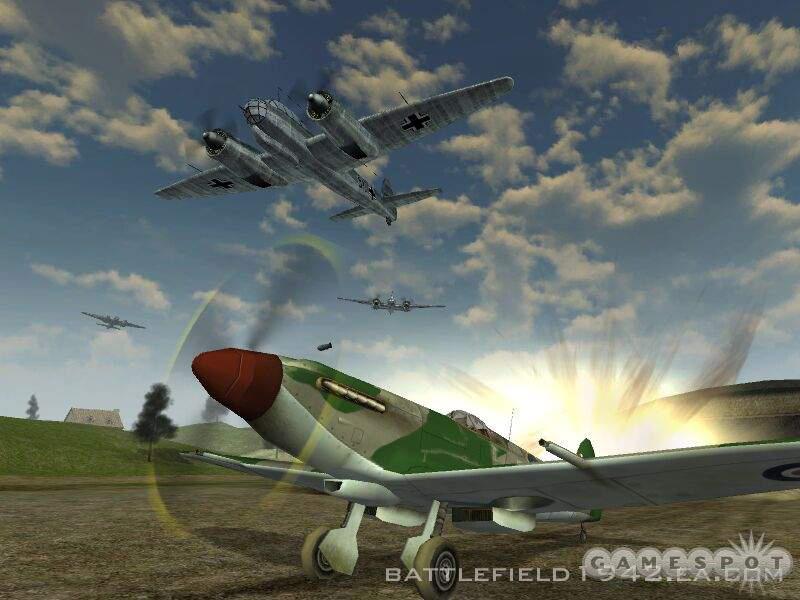
Of course, its popularity is also due to continued support after release, both from publisher EA and developer DICE, as well as from the fan community. EA and DICE have continually released new additions and maps for the game and have supplemented the game with new expansion packs, which, while not especially heavy on new map content, have added more-balanced vehicles and huge new areas with varied terrain. And yet, there are plenty of people who aren't playing the expansion packs, since they're too busy playing fan-created modifications like Desert Combat, a modern-day "total conversion" modification that takes place in the Gulf War. As a stand-alone game, Battlefield 1942 was an excellent game made better by retail expansion packs--and as a modifiable game supported by its loyal community, it's definitely one of our top 10 first-person shooters.
Doom
Platform: PC
Developer: id Software
Release: 1993
Doom did not invent the first-person shooter genre. But it might as well have. Even though developer id Software got its name on the map a couple of years prior to the 1994 release of Doom when it released Wolfenstein 3D, a straightforward but visceral, action-packed corridor crawl, Doom was the game that defined first-person shooters for years to come. More importantly, it achieved its blockbuster success solely through its incredibly high quality.
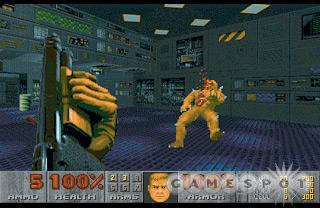
Basically, Doom brought a level of sophistication to the first-person shooter framework that instantly rendered Wolfenstein irrelevant, as good as that game was in its time. But after Doom, there was no turning back. Wolfenstein was all completely flat corridors and 90-degree angles. It's a small miracle that the designers were able to put together such a variety of different levels given those constraints, not to mention the paltry selection of four weapons, one of which was a near-useless knife. Doom, while not fully 3D (id Software's own Quake later took the genre into the third dimension, for keeps), added the appearance of depth to its stages. Elevators took you to higher ground, and enemies would fire upon you from all directions. The twisting, dangerous, and ominous corridors of a martian installation infested by the legions of hell burned a permanent imprint of themselves into the minds of millions of gamers who braved their depths time and time again.
Doom's arsenal of weapons is as legendary as its cast of enemies. A well-balanced, fun-to-use, and powerful-looking selection of firearms (plus a chain saw!) let you make short work of most bad guys, but they came at you in droves, and some of them--starting with the hairless, pink demons--could sustain surprising amounts of injury. Plus, the nightmare difficulty mode offered an extra added challenge: The enemies would respawn. In fact, Doom coined that word.
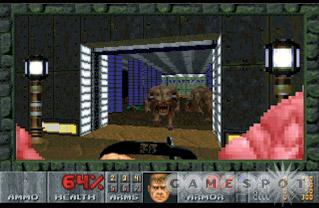
Doom also featured a four-player multiplayer mode, playable over a LAN or a modem, and this was its crowning achievement. While there were no specific multiplayer modes to choose from, one to four players could easily hop into the game, clear out a level of all the bad guys (or start a level without any bad guys in it), and then focus their attention on one another, blasting each other away until the wee hours. In fact, Doom's combination of competitive and cooperative gameplay was truly extraordinary--players could readily switch between shooting each other to bits and helping each other out. For many gamers of the time, Doom marked their first experience playing a multiplayer action game on their PCs, and that experience was a revelation.
Not that anyone questions Doom's status as one of the true classics of computer gaming, but the game holds up remarkably well to today's standards, despite being more than 10 years old. Take just about any successful first-person shooter released since, and you can easily trace its influences back to this one pioneering game, which thrilled and terrified millions and caused its fair share of controversy but ultimately kept us entertained for much longer than most games possibly could.
Tom Clancy's Rainbow Six
Platform: PC
Developer: Red Storm Entertainment
Release: 1998
Before Rainbow Six, almost every first-person shooter on the market looked and played like Quake. Id Software's seminal action game established the formula for every game to follow with over-the-top weapons, lightning-fast gameplay, and nightmare-inducing monsters. And though the Quake formula was undeniably exciting, there was something decidedly absent in the game: realism. In fact, realism was something that was missing from the genre altogether.
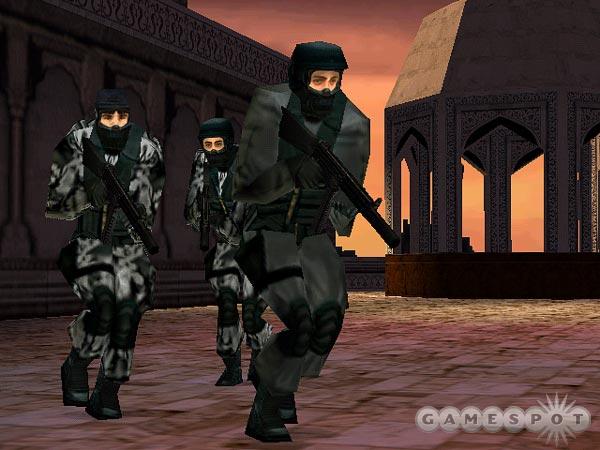
Enter author Tom Clancy, a man who had made himself one of the wealthiest entertainers in America with his riveting techno-thriller novels. In the mid-'90s, Clancy jumped into the PC gaming realm with a new company, Red Storm Entertainment. The idea was to exploit the synergy between different mediums by developing games based on Clancy's books. The crown jewel of this effort was Rainbow Six, a realistic, military-themed first-person shooter that rewarded solid tactics rather than twitchy reflexes. The idea was revolutionary and yet so obvious that it's a wonder no one else thought of it before.
Rainbow Six was a breath of fresh air in the genre, and gamers tired of Quake's "gibs" (the term used to describe an exploding body) embraced Clancy's idea of realistic gameplay. Everything, from the weapons and body armor to the equipment, was drawn from the real world (save, of course, for the controversial heartbeat sensor). Clancy used his formidable clout with the military so his development team could consult with elite counterterrorist operatives to get the lowdown on how to take down tangos (the game's term for terrorist). Rainbow Six was so realistic that it introduced the concept of one shot, one kill; there were no health packs or second chances. This forced you to slow down and think; no longer could you just run straight into a room and absorb bullet after bullet and shrug it off with a health pack. Now you had to sidle up to the door, throw in a flashbang grenade, and storm the room, ready to shoot any hostiles inside.
All this made Rainbow Six a huge hit with the multiplayer community. Kids who grew up playing soldiers in their backyard could now play as commandos online, and there was no more controversy about who killed whom first. It was so successful and popular that it established the realistic first-person shooter as a staple of the genre. Rainbow Six spawned a host of expansion packs and sequels, as well as a flood of clones and imitations, including Sierra's SWAT 3.
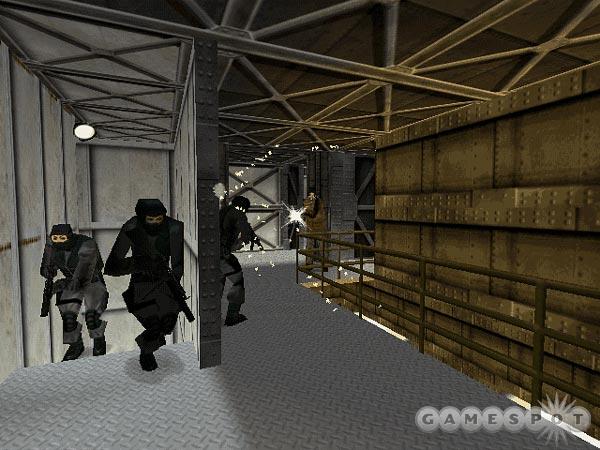
Clancy himself did a lot to make sure that Rainbow Six would be a blockbuster hit by writing the New York Times number one bestselling novel Rainbow Six, which fleshed out the plot of the game, though the ecoterrorist theme probably didn't make him any friends at the Sierra Club. And while Clancy sold his stake in Red Storm to Ubisoft in 2000, he maintains a long-term licensing deal that allows Ubisoft to develop more Tom Clancy-branded titles, including the Splinter Cell games and, of course, Rainbow Six 3: Raven Shield. The newest chapter of the Rainbow Six saga, the Raven Shield expansion Athena Sword, shipped this month, proving that the franchise shows no sign of slowing down anytime soon.
Unreal Tournament
Platform: PC
Developer: Epic Games
Release: 1999
Unreal's graphics were stunning--with colored lights, corona effects, and other eye candy at a time when the dull-colored Quake II was state of the art--but it never threatened Quake's online popularity because, at least in its initial versions, its multiplayer code wasn't anywhere near as smooth, and the demanding graphics could bog down the action at the worst possible moment. Just a year and a half later, Epic came out with Unreal Tournament and completely turned around the series' reputation with technically solid multiplayer support and an outstanding and diverse array of content. That id and Epic both produced multiplayer-focused shooters in 1999 was a testament to the genre's rapidly growing popularity and fans' high expectations--cutting out the linear single-player missions was seen as a way to focus in on the online content gamers really wanted.
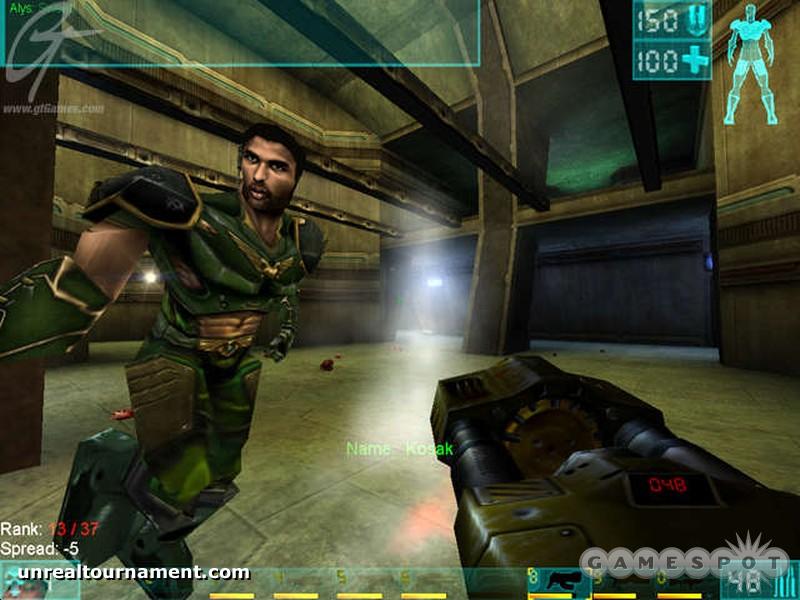
But while Quake III was tightly focused on deathmatch, with a handful of memorable capture-the-flag maps for good measure, Unreal Tournament packed in a lot more variety, with six game modes in the initial game, each with plenty of maps. Taking the action to a sampler of sci-fi settings such as a spaceship hurtling through space and skyscrapers so tall that there was low gravity at the top, the UT maps gave a startling sense of putting the battles in exotic locales. The premise, after all, was that the brutal action was all being broadcast in a sort of futuristic blood sport. Here and there display screens would flash the leaderboard as a reminder that capture-the-flag battles didn't just arbitrarily break out on a couple of asteroids floating through space but were placed there to make things more interesting for viewers, or rather participants, like you.
As much as it was obviously inspired by Quake, Unreal Tournament did have its own feel, with very fast movement speeds and an arsenal of overwhelmingly lethal weapons. Building on Unreal's distinctive features, location-based headshots made the sniper rifle a force to be reckoned with. The alternate firing mode of the shock rifle made timing-based combo attacks possible, while a supercharged rocket launcher fired up to six explosive rounds at once. Even the lowly pistol could be satisfying when you picked up a second and ran around Chow Yun Fat-style, with two guns throwing out rounds twice as fast. With the right skills, you could use these devastating guns to cut a swathe through an impressive number of opponents, and the announcer was right there to call out your accomplishments.
Unreal Tournament was the game to play if you weren't already a multiplayer veteran because of remarkably good bots, or AI opponents, that were even pretty good in team battles. The offline tournament modes weren't only good for honing skills and learning the ropes in new game types and maps. They were also a way to guarantee lag-free matches if you didn't have access to a fast Internet connection, and they generally opened the multiplayer game up to a much wider audience.
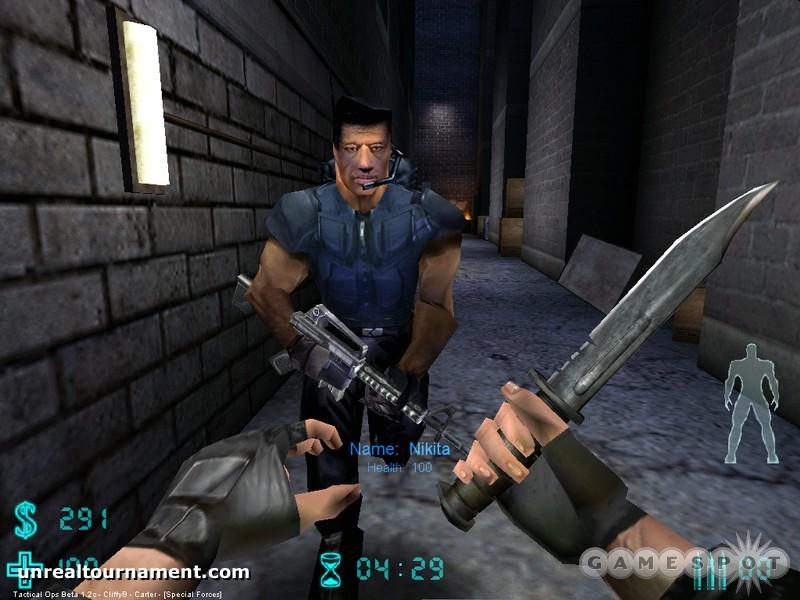
As much variety as UT had in its original release, what gave it staying power over the years were the mods and mutators. The mutator format made it easy to package and distribute minor gameplay tweaks, such as instagib game types or low-gravity settings. Since the mutators acted on the game servers, players didn't have to download anything extra themselves; they just had to join a game with a given mutator enabled. UT's mod scene also provided a decent selection of free content, such as the popular Tactical Ops mod, which aped the massively popular Counter-Strike but with UT's much better graphics under the hood. If anyone needs further proof of UT's greatness, there's the simple fact that there are still thousands of people playing the core game every day, not just the most popular mods.
Halo
Platform: Xbox
Developer: Bungie
Release: 2001
In the mid-'90s, many gamers thought Bungie had reached its creative zenith with Marathon. They were wrong. By the time the classic Mac and PC shooter had wasted millions of man-hours worldwide in 1999, the Bungie wizards were repackaging Marathon's rich story and innovative visuals into a next-generation first-person shooter. That game was Halo: Combat Evolved.
Ironically conceived as a real-time strategy game based on the Myth engine, Halo was soon retooled to show the future of war from the foot soldier's point of view. However, the game's hero was no ordinary grunt. Players got to slip on the MJOLNIR power armor of the Master Chief, an enigmatic supersoldier tasked with saving humanity from the Covenant, a conglomerate of alien races united by their religious zealotry.
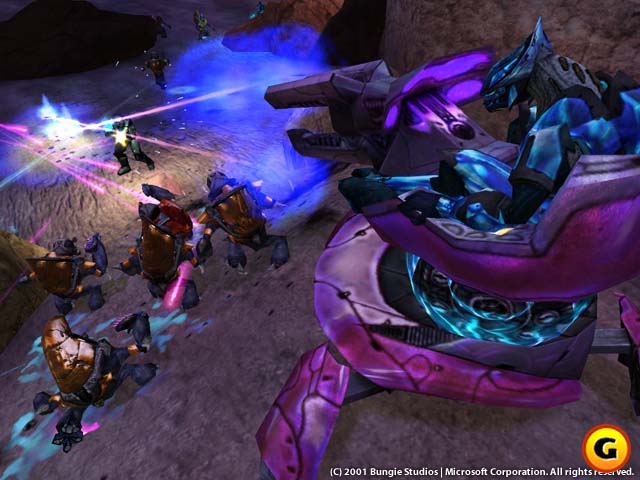
However, it would be hard to find a group of sentient beings more fanatical than Halo players. That's because the game's 17 hours of firefights could turn a Zen meditation master into an itchy-trigger-fingered adrenaline junkie. Seconds after he crash-landed on the Ringworld-like massive structure known as Halo, the Master Chief was hunted by hordes of Covenant troops. In an inspired touch, each Covenant rank had its own AI: Lowly grunts attacked en masse but scattered when caught solo (or when their superiors fell); mid-rank jackals took a craftier approach, rolling and strafing; the hyperaggressive elites lived up to their namesakes; and the hunters--well, let's just say we've seen what a fuel rod cannon can do up-close, and it isn't pretty.
Bungie attached several now-classic gameplay elements to Halo's already compelling Starship Troopers-like combat. While controversial at first, the two-weapon limit added a welcome touch of realism, forcing players to strategically choose between human slug-throwers and Covenant plasma arms. The inclusion of vehicles enhanced gameplay exponentially. After bogging around Halo's artificial landscape in the near-indestructible Warthog assault four-by-four, the Master Chief got to drive a Scorpion tank (complete with cannon), the Covenant Ghost antigravity skimmer, and the Banshee close-support aircraft.
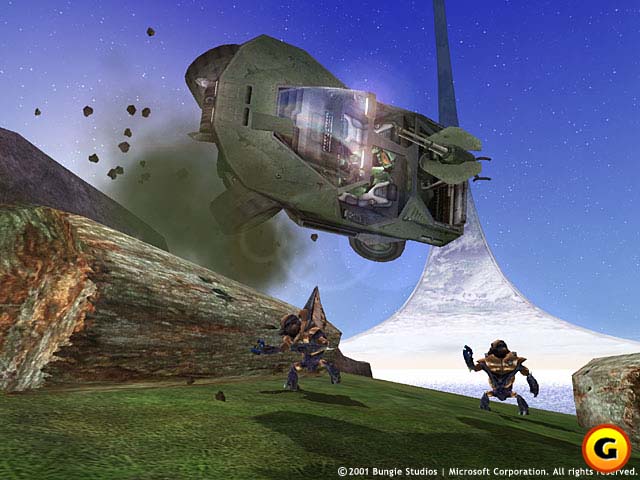
Though it came a year before Xbox Live, Halo's multiplayer component still stands out. Up to 16 people could engage in massive capture-the-flag or elimination bloodbaths over a LAN--a deliriously fun, if prohibitively expensive, proposition. However, Halo was one of the first next-generation console FPS games to offer co-op play, letting you and a buddy take on the Covenant together--a refreshing break from one-on-one deathmatches.
However, it's often the little things that separate the good game from the great game, and Halo was filled with brilliant details. It threw in not one but two whiplash-inducing plot twists involving a horde of fungicidal zombies and a cheerfully apocalyptic artificial intelligence. The game's still-dazzling visuals created a vibrant, breathing alien world, the hidden history of which was only hinted at. You always got a sense you were only scratching the surface of a much deeper narrative. That subtlety also extended to the Master Chief's mysterious background; his origins are never explained, other than the awestruck "He's here!" uttered by his fellow space marines or the terrified "It's him!" screamed by Covenant grunts.
No one can deny Halo's wider cultural impact. Besides inspiring the cult classic Red vs. Blue machinima series, it also spawned three novels that were acclaimed in their own right, thanks to author Eric Nylund (who wrote two of them). Its influence could also be seen in a series of concept SUVs, including Peugeot's eerily Warthog-like Hoggar. However, the most persuasive evidence of Halo's quality is its enduring popularity. The week of February 15, 2004--nearly two and a half years after it was released--the already triple-platinum title was EB Games' number 11 overall bestseller.
Half-Life
Platform: PC
Developer: Valve Software
Release: 1998
At the time Half-Life was released by Valve Software in late 1998, the first-person genre had fallen into a bit of a rut. The genre was still relatively new, and the market was awash in Quake clones and Doom clones that delivered only derivative gameplay. As 1998 drew to a close, two highly anticipated games were approaching release that offered hope for fans of action-packed shooters: SiN and Half-Life. Many placed their bets that SiN would be the game to win out in this duel, because of developer Ritual Entertainment's close ties to id Software. We all know how that battle turned out.
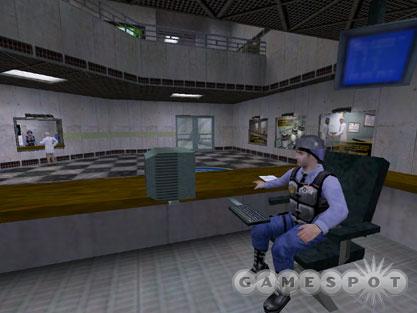
Half-Life succeeded not because of bleeding-edge graphics technology or an over-the-top, original arsenal of weaponry. It captured everyone's imagination because it succeeded in telling a great story and immersing you deeply into the game without breaking your suspension of disbelief. Instead of being divided into disruptive and discrete levels, the entire game was pretty much seamless from start to finish. To accomplish this, the world was broken up into zones. You'd notice a loading hiccup whenever you crossed from one zone to another, but other than that, there were no obvious transitions or clumsy interruptions. Even the start of the game didn't bore you with paragraphs of bland text to give context. You simply stepped on to a tram that took you on a short ride into Black Mesa Research Facility, which effectively set the stage for the game in much the same way a film would.
Even the design of armor, health, weapon, and ammunition was carefully planned. Gone were the industry-standard floating health boxes and spinning weapons that looked awkward and broke the immersion, and instead, health, weapons, and ammo were distributed in a more realistic, logical fashion. The hazard suit that protected you could be recharged from thoughtfully placed power stations. Ammunition could only be gained from storage lockers or the bodies of dead soldiers.
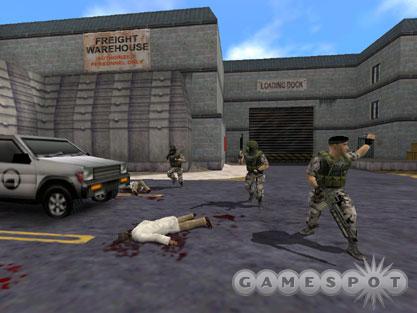
Half-Life also used scripted sequences in an artful and effective manner, depicting soldiers and scientists doing battle with aliens as you chose to participate or merely observe. These sequences gave the impression that you were only a small part of a much bigger story going on around you. In fact, those compelling sequences became the subject of a couple of Half-Life expansion packs like Opposing Force and Blue Shift, both of which added more meat to the Half-Life story. Other sequences played up the game's sci-fi, disaster theme, with lights winking out and buildings collapsing around you. Impressive AI design also played into the realism of the game, as the commandos would use team tactics against you, making effective use of cover, throwing grenades, and retreating when injured.
Another contributing factor to Half-Life's place as one of the top FPS games of all time is the design of its protagonist, Gordon Freeman. Instead of playing as a burly, hardened superhero, you took the role of a scientist at his regular job. While not all of us are genius physicists who work for top secret government laboratories, it was still easy to connect with Freeman, an otherwise ordinary man just caught in the wrong place at the wrong time. The fact that a simple crowbar became the signature weapon of the game speaks volumes about how the game's fans identified with Freeman's human instincts for survival and improvisation in the face of adversity.
If you're still somewhat unconvinced about the original Half-Life's significance to the industry, the fact that it still sells today should erase those doubts. The original game has enjoyed unbelievable longevity on store shelves, with the publisher simply repackaging the game over the years with add-ons and mods. More than five years later, platinum editions are still stocked at major retailers for upward of $40.
Anticipation over the impending release of Half-Life's sequel has gone beyond fever pitch. Though Valve missed its initial ship date promise last fall and has suffered the unprecedented setback of having its source code stolen by hackers, fans still eagerly await Half-Life 2, probably because the epic single-player experience from the original game has been matched by so few, if any, games since then.
Counter-Strike
Platform: PC
Developer: Minh Le (Gooseman) and Cliffe
Release: 1999
Counter-Strike is one of the most beloved and popular first-person shooters that has ever been created. Thousands of players at any given moment continue to play the game, despite its relatively outdated graphics, because CS is the closest thing to actually being out there as it gets. Its lasting popularity is all the more amazing considering that Counter-Strike was originally developed as a mod, and is still available for free to owners of Half-Life.
When you're a skilled player and you get in the zone during a match, it's like the computer monitor disappears. While it might sound a little spacey to someone who has never experienced it, your mind literally fills in the rest of the world around what you're shown onscreen. This spatial awareness that comes from playing the game a great deal lets you not only know the maps, but also gain an intuition for opponents' locations, based on the amount of time that has expired in a round. For the skilled player, the mere sound of gunfire off in the distance offers a great deal of information, which you can interpret by the volume of fire and the relative distance, timing, and distinct timbre of the weapons. The fact that such skills can be honed speaks a lot for the quality of the game design. Ultimately what Counter-Strike does so well that makes it the most popular first-person shooter to date is that it forces very few restrictions on you in terms of strategy and play styles. Counter-Strike offers the most compelling experience of terrorists versus counterterrorist operatives that currently exists.

Mechanically, one of the main reasons Counter-Strike has become the most played online first-person shooter in the world is its realistic damage and gameplay system. Before Counter-Strike, getting shot and shooting other players in most other FPS games didn't really have any consequences since the deceased simply respawned and started all over. Counter-Strike introduced the concept of having only one life per round, which made getting killed seem like a bad thing, while at the same time it made taking someone out all the more satisfying. This setup was even further strengthened by the fact that players who won got more money to buy better weapons and body armor. Make no bones about it: Counter-Strike helped invent the first-person tactical shooter as we've come to know it today.
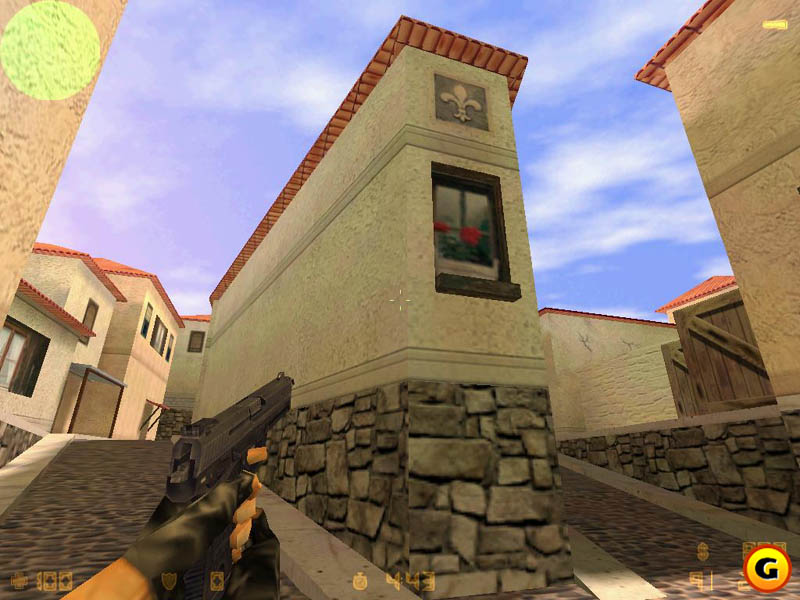
What's also been unique for CS and why the game has been able to retain its popularity over the years is that it's constantly evolving. Over the years Valve has issued countless updates that have ranged from invisible bug fixes to drastic overhauls. The most recent update, CS 1.6, has in fact been one of the most dramatic updates to date and even included new weapons and a fancy new user interface.
In addition to the sanctioned updates provided by the developers, the community surrounding Counter-Strike has also been a huge factor in sustaining and growing the game's popularity by creating countless custom maps as well as new character and weapon models. These assets have helped keep the game interesting over the years for even the most dedicated player. Every new map offers an entirely new world to explore, full of surprises and new challenges at every turn.
We'll have to wait and see what lies ahead for Counter-Strike, which is especially exciting right now with Half-Life 2 on the horizon. Conventional wisdom dictates that a sequel to CS would most likely use the Half-Life 2 engine. Whether the story of the game that started as a humble modification so many years ago will end with a sequel or simply continue to evolve, Counter-Strike will always be one of the greatest FPS games ever created.
Duke Nukem 3D
Platform: PC
Developer: 3D Realms
Release: 1996
Back in 1996, a first-person shooter wasn't really the place to go if you were looking for a game with real personality. Instead, the games simply focused on the visceral experience of gunning down as many enemies as you possibly could. Duke Nukem 3D gave a face--and a voice--to the genre. While some of Duke Nukem's lines were pretty hokey, the simple act of adding character to a first-person shooter went a really long way, making the game feel larger and more alive than many of the shooters to come before it.

But that's not to say that Duke Nukem 3D's only strong point was that Duke himself mouthed off like the star of an action movie. The level of interactivity with the environment was much greater than in previous games. Some of this may seem a little silly now--were we really so impressed back then by something as seemingly simple as toilets that you could flush? But all the little things you could do, from flushing toilets to simply blowing them up, made the world feel all the more alive.
A lot of the game's environments had a more realistic feel to them. Doom was simply set in one hellish level after another. Duke had city streets, complete with adult film theaters, bookstores, and fast-food joints. Combined with the ability to interact with a lot of different objects in the world, this gave the game a wholly unique feel. Lots of hidden movie references and other little touches also enhanced the game's world.
But enough about ambience and environments and interactivity. Duke Nukem 3D's gameplay was also pretty outstanding. The game's single-player campaign put you up against a variety of wily foes in a lot of different environments. Solid boss battles throughout the game's episodes provided some closure to the otherwise endless stream of pig cops and other bad guys looking to knock Duke's block off. The game's network support, which allowed for multiple players to play together over a LAN, added an extremely addictive experience to the list.
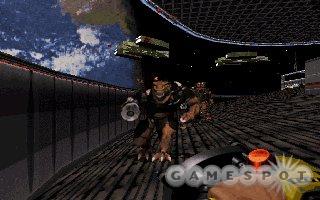
Part of what made the multiplayer so much fun was Duke Nukem's weapons. Trip mines, while almost totally useless in single-player mode, were an insane addition to the game that hadn't really been seen in other shooters. Mining common corridors and preventing players from moving freely was a ton of fun. The game's pipe bombs were a lot cooler than typical grenades. And the rest of the list contains crazy weapons, like the freeze gun, which let you freeze your opponents into a block of easily shattered ice and the shrink ray, which let you humiliate your opponents by shrinking them and squashing them flat. The game also had interesting multiplayer options like cameras spread out through the level--you could use these to try to keep tabs on where your opponents were by either sighting them, or noticing that they had picked up certain items, though standing in front of a camera control too long would leave you vulnerable yourself.
Between the game's good-natured attitude, the great level design, and solid engine, Duke Nukem 3D helped shape the world of first-person shooters, and it's an extremely easy choice for our list of the top 10 games in the genre.
GoldenEye 007
Platform: Nintendo 64
Developer: Rare
Release: 1997
During the Nintendo 64's all-important first year, the console saw more than its share of first-person shooters. However, the bulk of these titles consisted of watered-down, generally faulty ports of popular PC games, like Doom and Hexen, and the few originals that did pop up weren't much better. In fact, this problem wasn't even just limited to the N64--most PlayStation FPS titles suffered from the same trend during that era as well. This, of course, all changed late in the summer of 1997, when Nintendo, along with Rare Limited--its then most highly touted first-party developer--released its film-to-game representation of Pierce Brosnan's first outing as famous superspy James Bond. That game was GoldenEye 007, and ultimately, it changed the way we viewed console first-person shooters.
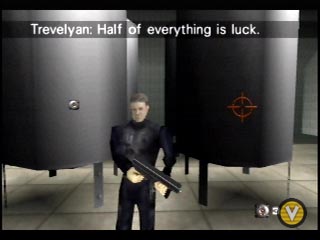
Like any good film-based game, GoldenEye took the most exciting aspects of its representative film, took a few liberties with the story here and there, and essentially turned GoldenEye's story into an absolute blast to play. As the story went, you, as 007 himself, were up against a former 00 agent named Alec Trevelyan, who had concocted a plan to steal a Russian satellite, which contained a weapon that could obliterate all electrical functionality for an entire city. In the game, the plot wasn't really the most important factor, and for the most part, your goal was simply to run around shooting hapless soldiers and members of Trevelyan's criminal organization, while occasionally jumping off massive dams, planting explosives, escaping exploding trains, and driving tanks through St. Petersburg. But then, all of these neat tricks would only matter if the game's first-person shooting mechanics were any good to begin with--and boy, were they.
As with any proper FPS, GoldenEye featured a host of different weapon types, ranging from the standard shooter fare, to the more Bond-inspired gadgetry. Aside from having access to an excellent array of handguns, automatics, shotguns, rocket launchers, and sniper rifles, you could also use things like mines (timed, proximity-based, or remote), plastic explosives, throwing knives, a standard melee knife, a taser, and Bond's always trusty watch laser. Different weapons came into play during different missions, and your available arsenal always kept the action varied and exciting. Of course, periodically being able to drive around a massive tank and run down cars while blowing massive holes in anything that got in your path...well, it certainly didn't hurt.
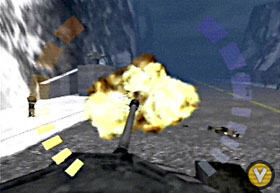
Now, what would any first-person shooter be without a multiplayer component? Sure, the Nintendo 64 predated console online capabilities, and console FPS multiplayer at that point was pretty pathetic, but somehow GoldenEye made it work, and work well. Although the game featured only a deathmatch mode, that was really all you needed. You could select one of several different maps, like an Aztec level and the Severnaya bunker, and you could use character skins of any of the game's enemies as well as a host of classic bond villains, like Oddjob, Jaws, Baron Samedi, and Mayday. Sure, it was just simple deathmatch fun, but regardless of its simplicity, you can't argue with how much fun it really was.
When asked, many people will tell you that to this day GoldenEye is one of the best Bond games and also one of the best games period of its generation. These statements are rather difficult to refute when you consider just how incredibly fun the game was for its time and how well it really still does hold up today. For its era, GoldenEye was a fantastic achievement, and in this era, it stands up as a true classic.
Quake
Platform: PC
Developer: id Software
Release: 1996
Let's get one thing straight: Quake's rocket launcher is the single best weapon in any game, ever.
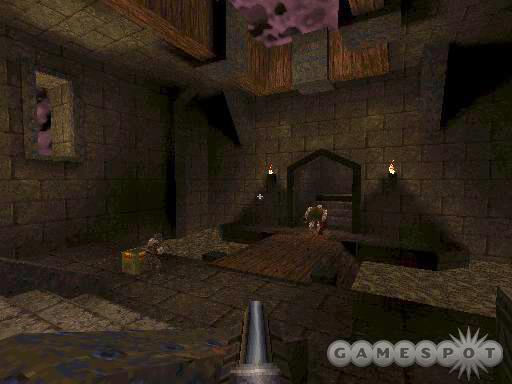
As tempting as it is to let that statement stand on its own, Quake's inclusion on this list bears just a little more justification. Putting aside the rocket launcher for a moment, Quake is most memorable as the game that brought real, honest-to-goodness multiplayer to the masses. Sure, id Software's previous megahit, Doom, introduced the concept of a bunch of players running around the same map trying to frag each other, but Doom's deathmatch implementation allowed just four players at a time and was limited to local-area networks; in other words, the only people playing four-player Doom were obsessed college students and corporate drones on their lunch hour.
Quake made deathmatch accessible to a far wider audience. The very first shareware release let anyone with even a paltry 28.8kbps Internet connection jump into 16-player games that ran pretty smoothly, considering that the slow network speed most players used in 1996 caused some latency problems in the first few months of the game's release. Networking issues notwithstanding, Quake's deathmatch was (and remains) the most frenetic, visceral competitive gaming experience we've ever had. Often imitated but never bested, Quake is the game that hooked us incurably on multiplayer gaming.
For one thing, the game was fast. Most online first-person shooters these days are of a slow, tactical nature, but Quake's frantic gameplay was created by the id Software brain trust when Counter-Strike was still a gleam in Gooseman's eye. This is where the rocket launcher comes in. Quake did have other weapons, like the nailgun, lightning gun, and axe, but id threw silly notions like weapon balance right out the window when it spec'd out the properties of that almighty death-bringer. The rockets flew at a speed too fast to dodge, so if you were up against an expert player who was able to lead you properly, you didn't have a chance. The splash damage was intense, too--you could aim roughly near your opponents' feet and do considerable harm, not to mention bounce them around like rag dolls. And the strength of the rocket was almost absurd; a player with full health and no armor would be killed in a single hit. Quake's basic deathmatch boiled down to a balls-out contest between players to control the rocket launcher and therefore dominate the match.

Of course, there was far, far more to Quake than the basic deathmatch game. Id Software is legendary for providing tools and after-release support for its games, and it took this idea to a new level with Quake. An entire modding community (and in fact, a cottage industry) sprang up around the game, with mods like Capture the Flag and Team Fortress giving players literally years' worth of extra play value. Quake was also the first PC game with hardware 3D support to really reach the mainstream--the free GLQuake add-on looked absolutely amazing when it was released and sold many, many 3dfx cards single-handedly.
Isn't it telling that we made it through this entire column without mentioning interesting things like Quake's then-revolutionary 3D engine or Trent Reznor's weird, ambient soundtrack? Yeah, the multiplayer is that good. We even named Quake one of the best games of all time because of it. The halcyon days of the online Quake community may have faded now that there are dozens of multiplayer FPS games on the market, but Quake's hectic, satisfying deathmatch action will always hold a special place in our hearts.
Got a news tip or want to contact us directly? Email news@gamespot.com
Join the conversation